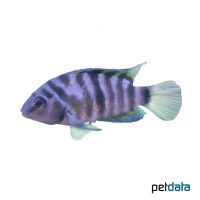Convict Cichlid (Amatitlania nigrofasciata)
| Convict Cichlid Amatitlania nigrofasciata | |
|---|---|
| Name | Convict Cichlid |
| Name Lat. | Amatitlania nigrofasciata |
| Synonym | Cichlasoma nigrofasciatum |
| Family | Cichlids |
| Family lat. | Cichlidae |
| Order | Cichlids |
| Order lat. | Cichliformes |
| Origin | Central America |
| Habitat | Streams, lakes |
| Diet | Omnivore |
| pH | 6.0-8.0 |
| Behavior | Aggressive |
| Keeping | Pair |
| Care Level | Easy |
| Reproduction | Cave spawner |
| Breeding | Simple |
| Life Span | 8-10 years |
| Protection | No |
| Metric Units | |
| Size | 10-12 cm |
| Temperature | 24-28 °C |
| Hardness | 5-25 °dH |
| Aquarium | ~ 200 l |
| US Units | |
| Size | 4"-4.7" |
| Temperature | 75-82 °F |
| Hardness | 89-445 ppm |
| Aquarium | ~ 50 gal |
Distribution and habitat
The zebra cichlids are widely distributed in Central America, from Guatemala through Honduras, El Salvador, Nicaragua and Costa Rica to Panama. They live in a variety of habitats, such as shallow, slow-flowing streams and small rivers, lakes and ponds with numerous shelter and hiding places, such as roots, branches and dead wood.
Maintenance
The aquarium should have a robust border planting, with many hiding places (stones, roots), and offer free swimming space. A substrate of sand or fine gravel covered with some foliage (e.g. sea almond leaves) and slightly subdued light (floating plants) is ideal.
No ammonia, ammonium and nitrite should be detectable, the nitrate value should not exceed 100 mg/l. To ensure the water quality and oxygen content, a filter and heater adapted to the aquarium size is required, as well as lighting for the species-appropriate day-night rhythm of the animals.
Diet
The food supply consists of live, frozen and dry food. For a balanced diet, feed once a day with a high quality sinking dry food for cichlids (pellets, granules, chips) as well as artemia, mysis, tubifex, red mosquito larvae, etc. (live or frozen). They also need plant food, such as algae leaves and commercial green food (kelp, spirulina)
Only feed as much as will be eaten within a few minutes. A regular and varied diet promotes health and increases resistance.
Behaviour and compatibility
They should be kept in pairs and are only conditionally suitable for a community tank due to their aggressiveness. Especially during the spawning season they defend their territory very emphatically and attack even much larger fish. Keeping several pairs is only recommended in a much larger and richly structured tank.
Basically, only compatible fish species with similar demands on water quality and water temperature may be socialized.
Sex dimorphism
The larger males have pointed fins. Adult males sometimes have a fat hump on the forehead. Females show a characteristic dark spot on the dorsal fin and are more colorful at spawning time.
Reproduction and breeding
They spawn in a cave. The female performs brood care, while the male defends the territory. After 3-4 days, the fry hatch and are then housed and guarded in a bottom pit prepared outside the cave until they swim freely after 4-5 days. Often the school of fry is still guarded by the parents for some time.
Fry must be fed several times a day with special rearing food (Artemia). In community tanks breeding is hardly possible, because the fry are easy prey.
Important
They like to burrow and often damage the roots of plants.
The well-being of the fish should be checked regularly. The temperature should be checked daily, the pH, hardness and nitrate value at least every 14 days. Regular partial water changes are recommended, even if the contaminant level has not yet reached the upper limit. Sudden changes in water quality should be avoided. Newly introduced fish must be accustomed slowly to the water in the aquarium.
Further literature can be found in your pet store.
References
Text: Petdata; Image: Petdata
Source: BMELV (1998): Tierschutzgutachten - Haltung von Zierfischen (Süßwasser); RIEHL & BAENSCH (2006): Aquarien Atlas Bd. 1, Mergus Verlag; ENGELMANN (2005): Zootierhaltung - Tiere in menschlicher Obhut: Fische, Verlag Harri Deutsch
- Gemäß § 21 Abs. 5 Tierschutzgesetz idgF
